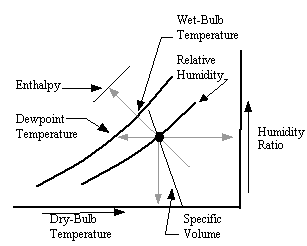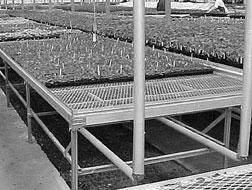
Figure 1. Psychrometric chart.
Jessica J. Prenger
Research Engineer
Peter P. Ling
Assistant
Professor
A drier greenhouse environment is a powerful defense against plant diseases. This fact sheet introduces climate control techniques that reduce condensation on the plants and prevent condensate water on the greenhouse coverings from dripping onto the crop canopy. Humidity is a particular concern since crop needs, disease and pest control, and energy conservation often require conflicting humidity control strategies. While researchers work to develop decision support for humidity control in these situations, the first step toward disease prevention in the greenhouse is reducing freestanding water on plant surfaces. A water film on a plant provides the ideal condition for pathogens to grow and infect crops. Condensation (dew) occurs when moisture in warm air condenses on cool leaf and covering surfaces.
Integrated disease and pest management (IPM) strategies use alternative methods for controlling pests and diseases, reducing chemical applications while maintaining or improving greenhouse production. One of the most important factors involved in disease prevention and management is environmental control. Climate problems such as high humidity and poor ventilation are linked to common greenhouse plant diseases such as Botrytis cinerea (gray mold), downy mildew, and white rust. Thus, incorporating environmental control into IPM programs has become essential.
To understand why condensation occurs and how to fight it, the relationship between air and water vapor should be understood. Environmental control involves conditioning air-water vapor mixtures in processes like heating, cooling, humidifying, or dehumidifying. The psychrometric chart (Figure 1) summarizes the properties that affect moisture in the air and condensation on surfaces. Typical greenhouse sensor measurements like relative humidity and temperature are used to determine hard-to-measure properties like dew point temperature. An undesirable situation occurs when condensation forms on a surface, such as a leaf, whose temperature has fallen below the dew point of the moist air surrounding it. Below that temperature, the moisture in the air condenses on the surface to form droplets of free water (Strobel and Stowell, 1999). Applying psychrometric relationships, a climate control system can modify the environment to achieve new conditions. An example of this is ventilating the greenhouse to remove moisture. Ventilating air is warmed as it enters the greenhouse, and since air expands as it is warmed, it can hold more moisture. Thus, the ventilating air absorbs moisture as it passes through the building, and is exhausted to make room for dryer air. The ventilation process removes moisture, reducing the humidity ratio and lowering the dew point temperature (Figure 1). Thus, the threat of condensation in a greenhouse is diminished. (For more details about the psychrometric properties of moist air, please refer to Ohio State University Extension Fact Sheet AEX-120-99, "Using a Psychrometric Chart to Describe Air Properties.")

There are some simple and practical things growers can do to reduce greenhouse moisture problems. Most of these solutions follow a straightforward approach: eliminate free water to remove breeding grounds for disease. Our series of four fact sheets explains methods for keeping plant surfaces dry and disease free.
AEX-801. Bottom Heating and Between-Row Heating: Keeping plant surface temperatures above the dew point (see psychrometric discussion above) prevents condensation. Locating the heating distribution system nearer or below the crops can improve the microclimate by providing heat more directly to the plants and by stimulating air circulation.

AEX-802. Keeping Plants Warm with Thermal Screens: Providing better insulation using thermal screens is another way to keep the climate warmer. However, thermal screens require special attention to humidity build-up under screens and condensation on the material.
AEX-803. Improving Air Circulation: Circulating air with horizontal air flow (HAF) fans or a Fanjet and perforated poly tube often alleviates mild humidity problems. The circulation distributes warm air around the plants and encourages evaporation of the condensate into the air.
Future fact sheets in this series will discuss dehumidifying the environment efficiently. Climate control manipulation can remove moisture from the air. Heating and ventilation in combination is the most common method of dehumidification in a greenhouse. Ventilation brings in air, which is heated, allowing it to absorb some of the moist air from the building before exhausting it to the outside. The increased heating load can be expensive, and heating-ventilation control should be considered carefully.
Growers should note that condensation on the greenhouse covering is not a problem unless the condensate falls on the plants. Therefore, coverings and screens are often coated with anti-condensation additives or wetting agents that prevent dripping, and gutters are used to trap the water. The suggestions and techniques described in the fact sheets help alleviate the problems of high humidity and condensation. These measures could even replace pesticide application programs as the most effective ways to combat diseases in the greenhouse. All are important steps in an integrated disease management plan.
Aldrich, R.A. and J.W. Bartok, Jr. 1989. Greenhouse Engineering. NRAES-33. Northeast Regional Agricultural Engineering Service. Cornell University, Ithaca, NY.
Bakker, J.C. et al. (Eds.) Greenhouse Climate Control - An integrated approach. Wageningen, The Netherlands: Wageningen Pers. 1995.
Kamp, P.G.H. and G.J. Timmerman. Computerized Environmental Control in Greenhouses - A step by step approach. Ede, The Netherlands: IPC-Plant. 1996.
MWPS. 1983. Structures and Environment Handbook. Eleventh Edition. MWPS-1. Midwest Plan Service. Iowa State University, Ames, IA.
Strobel, B.R. and R.R. Stowell. 1999. "Using a Psychrometric Chart to Describe Air Properties." Fact Sheet AEX-120-99. Ohio State University Extension.
Teitel, M., I. Segal, A. Shklyar, and M. Barak. 1999. A Comparison of Pipe and Air Heating Methods for Greenhouses. J. Agric. Eng. Res. 72:259-273.